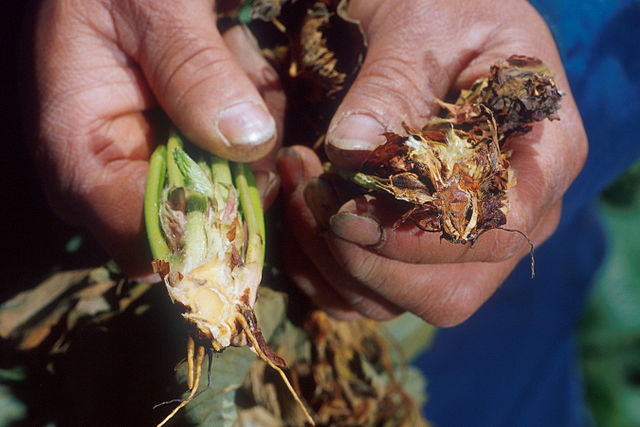Introduction
Verticilium wilt (Verticilium) is a fungal disease that infects over 400 plant species. It is caused by six species of the Verticilium genus: V. dahliae, V. albo-atrum, V. longisporum, V. nubilum, V. theobromae, and V. tricorpus. Numerous vegetables, fruit trees, flowers, field crops, and woody ornamentals are vulnerable to infection by Verticillium wilt. The symptoms of Verticilium wilt vary between plants. Most infected plants experience a general wilting of their stem and leaves. Verticilium wilt infections often result in plant mortality for smaller and older plants, as well as for seedlings.
Distribution & Habitat
Verticilium wilt is prevalent throughout the temperate and tropical regions of the world. It may occur wherever susceptible plants are present.
Hosts
Verticilium wilt attacks a wide range of hosts. Trees and shrubs that are commonly infected include ash, black locust, box elder, camphor tree, carob, carrotwood, elm, catalpa, cork tree, elder, elm, flannel bush, fringe tree, golden-rain tree, horse chestnut, pagoda, sassafras, serviceberry, smoke tree, tree of heaven, tupelo, tulip tree, walnut, yellowwood, and juniper. Cabbage, celery, cucumber, eggplant, lettuce, melon, pepper, potato, pumpkin, radish, rhubarb, and tomato are the most frequently infected vegetables. Susceptible flowers include aster, begonia, carnation, chrysanthemum, dahlia, geranium, impatiens, peony, petunia, snapdragon, and sunflower. Vulnerable fruit include barberry, blackberry, black raspberry, select cherries, grape, raspberry, Ribes sp., strawberry, and watermelon.
Disease Cycle
The disease cycle of Verticillium wilt is similar across all of the Verticillium species. There is one major difference: each species of Verticilium constructs its own type of survival structure. V. albo-atrum forms a structure out of mycelium, V. dahliae establishes one from microsclerotia, V. nigrescens and V. nubilum develop a structure from chlamydospores, and V. tricorpus creates a structure composed of all three. The survival structures are situated around and beneath the soil surface, near previously infected plants.
When the roots of a vulnerable plant approach a survival structure, they secrete exudates intended to shield them from harm. However, the exudates unwittingly have the opposite effect. Instead, they promote the germination of the fungus on the survival structure. The fungus grows outward from the survival structure, rapidly progressing toward the roots. Once the fungus has established contact with the roots, it infiltrates the plant through various natural root openings.
Once the fungus has entered a plant, it spreads via hyphae or spores. As the fungus advances into the plant’s vascular system, it gives rise to fruiting structures, which produce sexual spores called conidia. When the conidia are released into the xylem, they rapidly colonize the plant. Infected plants may be colonized entirely within 24 hours. During this stage, the fungi erect their survival structures. If the host expires, it may collapse into the survival structures, causing them to release more inoculum into the environment. The survival structures remain where they were first constructed, awaiting the approach of vulnerable roots so that they may begin the cycle anew.
Symptoms of Infection
When a plant is infected by Verticillium wilt, its vascular system is disrupted. This prevents the proper distribution of water and nutrients throughout the plant. Due to the lack of sufficient water and nutrients, the plant’s stem and leaves wilt. Smaller plants and seedlings are often quickly killed. In larger plants, infections may not be as severe. Many larger plants will stave off Verticilium wilt infections, but may be weakened as a result. Sometimes infection symptoms may be confined to the lower portion of a plant, or localized to a few branches. New growth formed by infected plants will often be stunted. Infected leaves will typically become necrotic, before being shed prematurely.
Management
- Remove and dispose of infected annuals and perennials. Avoid composting diseased plant materials.
- Prune damaged or infected portions of ornamental plants. Sterilize pruning tools between each cut using a solution comprised of nine parts water and one part bleach.
- Plants should be pruned routinely to promote plant vigor.
- Avoid mechanical wounds to plants.
- Ensure that plants are maintained through sound cultural practices. Apply a layer of organic mulch around the base of vulnerable plants to insulate the root system and improve the soil quality.
- Certain plant species exhibit an increased resistance to Verticilium wilt. These plants include apple, beech, birch, all conifers, crabapple, dogwood, eucalyptus, fuchsia, heather, hornbeam, katsura tree, lilac, mountain ash, mulberry, plane tree, poplar, privet, rose, sumac, sweetgum, sycamore, Viburnum sp., and willow. African violet, ageratum, baby’s breath, hollyhock, periwinkle, primrose, and zinnia are popular flowers that are immune to Verticilium wilt. Vegetables that are immune to Verticilium wilt include asparagus and beanpea.
